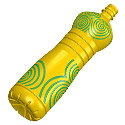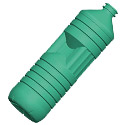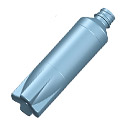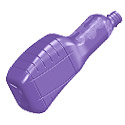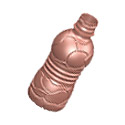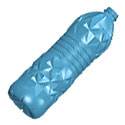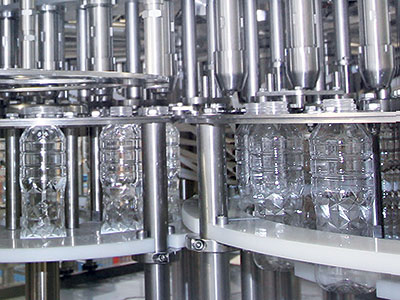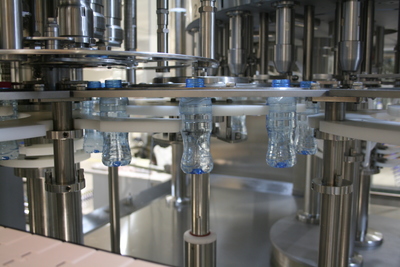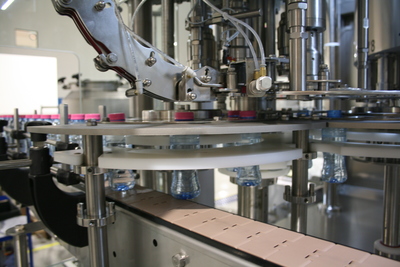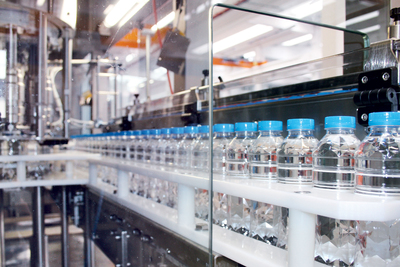Hyper-clean electronic fillers
HEVF series (still products)
HEVF - Electronic volumetric filling system
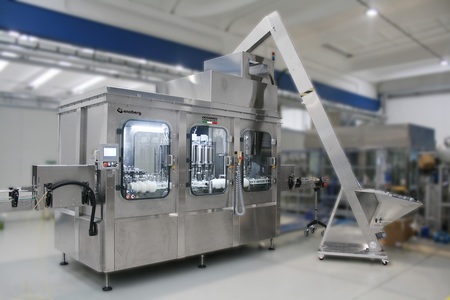
The thirty-year experience of Enoberg (company part of the SMI Group) in the manufacturing of fillers and the growing market demand in terms of hygiene, reliability, simplicity of machine maintenance and use have led the company to manufacture the new HEVF range (Hyper-clean Electronic Volumetric filling systems for Flat products).
The volumetric electronic filling system is based on the use of a flow meter for each filling valve
The flow meter detects the flow of the product that fills each bottle; once the correct volume is reached, the flow meter controls the closing of the filling valve.
The products that can be worked by HEVF fillers are:
- still and carbonated water
- iced tea
- clear juice (such as pineapple)
- fresh milk (7 day shelf life)
- wine and balsamic vinegar
- apple vinegar
- thick juice (such as pear)
- syrups
- soy sauce
- detergents and sanitizers
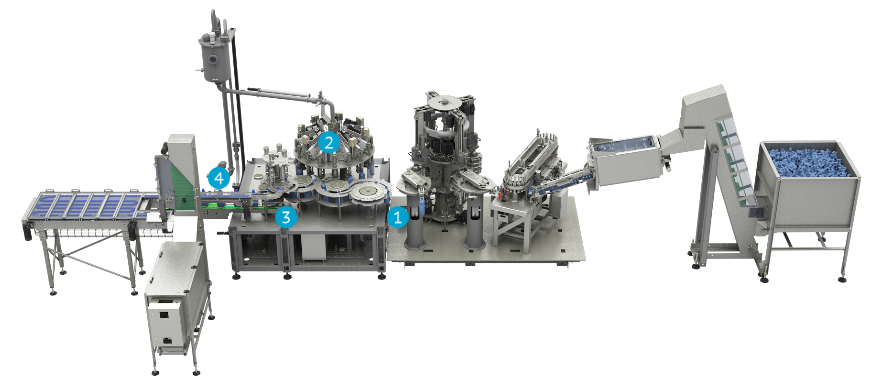
1Empty bottles transfer
After being manufactured by the stretch-blow moulding machine, empty bottles are conveyed from the blower to the filler by "neck-handling" direct transfer by menas of adjoining star wheels. The star-wheel at the blowmoulder outlet is equipped with grippers electronically synchronised with the brackets of the starwheel at the filler inlet.
2Filling
Once the filling station is reached, a gripper grabs the bottle by the neck and places it under the filling valve.
The product to be filled is positioned in an external manifold, from which it is conveyed to the filling valve through a specific pump. The electronic volumetric filling process is carried out through magnetic flow meters, placed upstream of each filling valve. During the filling process, the flow meter detects the amount of product that goes through the valve. The measurement is based on pulses, that are compared to the ones set for the format in use. When the set value is reached, the closure sign is sent to the filling valve.
At this stage the filled bottle is transferred to the capper.
3Capping
A shaped star wheel allows to center the bottle under its capping station. The cap coming from the feeding system is picked by a transfer star wheel called “pick and place”. The capping head picks the cap from the star wheels and applies it to the bottle. According to the cap to be applied (plastic screw cap or pressure cap), the capping system can operate by rotation or pressure.
The filled and capped bottle is transferred to the outfeed conveyor.
4Outfeed conveyor
The filled and capped bottles are transferred to a chain conveyor that conveys the bottles outside the machine. This conveyor is equipped with an automatic height adjusting system, that allows to adjust the bottle base according to the bottle height.
- Frame made of AISI 304 stainless steel
- Tempered glass safety guards and sealing gaskets that hermetically seal the filling environment from the external one
- The motion of the machine carousels is driven by robust gears placed in the machine base
- The filling section is completely isolated from transmissions, that therefore do not come in contact with the liquid to be filled
- Filling valve fully made of AISI 316 and characterized by an easy maintenance
- High-precision flow meters installed next to the filling valves
- Dummy bottles with a manual insertion to ensure a complete cleaning and sanitation of the components in contact with the product (dummy bottles with an automatic insertion are available on request)
- Product pump that allows to keep the pressure constant during the filling operation
- Quick format changeover of the bottle guide equipment
- Parameters of each format directly controlled through HMI
- 7'' HMI touch screen (15'' available as an option)
Maximum filling precision
The filling process is extremely precise, thanks to the use of the flow meter, an electronic device installed near each valve that detects the flow of the product that fills each bottle by counting the pulses and sends the filling valve the closure sign, once the value of the format in use is reached.Compact solution and reduction in transportation costs
The fully welded frame gives the whole machine a solid and resistant structure. This allows a considerable space saving for the machine positioning in the plant. Furthermore, it is possible to transport the filler inside a 40' high cube container (available for most models).Workability of a wide range of products
A wide range of products can be filled thanks to the valve terminal that is changed according to the type of product.High level of hygiene
The machine base plate is inclined towards the drainage points. This allows the drainage of liquids that are on the machine base and a higher level of hygiene.Protection of electronic components
The electric manifold and the drives of the filling valves are isolated from the filling environment through airlocks. This allows to protect electronic components from the contact with liquids and to perform COP washing operations on the whole filling carousel.Separation between wet and dry manifolds
The entry of the filling product and the return of the washing product take place in the lower part of the machine through a ceramic manifold equipped with two gaskets (one for sealing and one for safety) and equipped with an inspection light. This leads to the neat separation between “wet” manifolds (product and CIP return) and “dry” manifolds (electric and pneumatic), in addition to a high durability.Fully washable filling valve
Fully sanitized filling valve thanks to dummy bottles with manual or automatic (optional) positioning.Efficient control of two filling speeds
The valve allows to control two filling speeds in order to fill homogeneously and efficiently, with no product leakage from the container. The duration of the filling cycles (slow or fast) can be controlled easily and intuitively through the recipes inside the man-machine interface (HMI Posyc®).Contact us
- SMI S.p.A.
- Address: Via Carlo Ceresa, 10
24015 San Giovanni Bianco BG
Italy - Phone: +39 0345 40.111
- E-mail: info@smigroup.it
- Monday - Friday: 07:45 - 17:30
Saturday - Sunday: Closed
Privacy statement
DATA PROTECTION AND PRIVACY
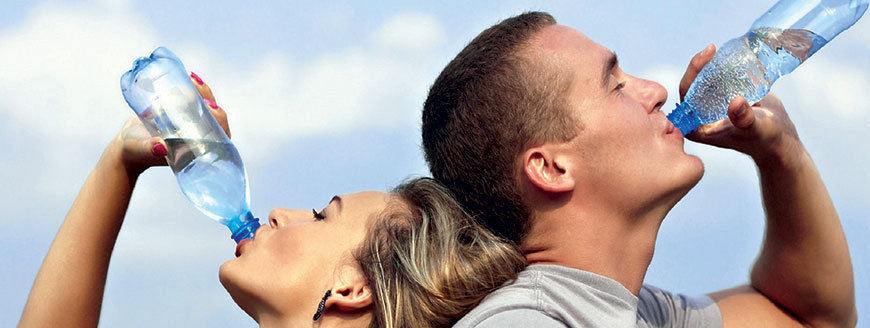
The European Regulation 679/2016 (GDPR) on the protection of personal data has been fully applicable since May 25th, 2018. This is an important goal, because it lays down rules relating to the processing of personal data for all Countries within the Union. Every company of the SMI Group planned a series of activities, assets or operational modes to comply with the regulation and put into practice the protection of personal data. Here is a list of actions taken to comply with the European Regulation and our policy on personal data processing.
![]()
Lawfulness of processing
All activities relating to personal data processing shall be lawful (consent, contract obligations, vital interests of the data subject or of third parties, compliance with legal obligations to which the controller is subject, public interest or exercise of official authority, legitimate interest pursued by the controller or by third parties).
![]()
Information document
The information statement has been improved and updated to the new regulations (art. 13 and 14 GDPR).
![]()
Rights of the data subjects (right of access, right to erasure-right to be forgotten, right to restriction of processing, right to object, right to data portability)
Technical and organization measures have been adopted to ensure the data subject's exercise of his rights and to meet the data subject requirements.
![]()
Controllers, processors
Based on the new principle of “accountability”, SMI Group organization was re-defined, in order to proactively ensure integral compliance with the Regulation.
Redefinition of the role of data processors and service suppliers whose activity implies personal data processing.
![]()
Risk of data processing; accountability measures taken by controllers and processors (Impact assessment, record of processing activities, security of processing, data breach)
The “Conformity document”, including records of data processing activity, plans, adopts and demonstrates all technical and organizational measures taken to adequately perform the data processing activities and specifies the necessary procedures to be adopted to notify data breach.
![]()
Transfer of personal data to international organizations
Smi Group adheres to the general principles and guarantees concerning the transfer of personal data to third Countries.
The Controller is:
SMI S.p.A.
Head office: Via Carlo Ceresa, 10 - 24015 San Giovanni Bianco (BG) - ITALIA
P.I.: 04471940165 - C.F.: 03942700166 - R.E.A.: 421708
For further information, write to: privacy@smigroup.net
According to the European Regulation 679/2016, the data subject is entitled to exercise the rights set forth in the Regulation.
The integral version of art. 15; 16; 17; 18; 20; 21; 77 of the European Regulation is attached to this document.
In order to exercise your rights, please send the application form duly filled in to the Controller's address.
Legal notice
SMI S.p.A. con Unico Socio
Società sottoposta a direzione e coordinamento da SMIGROUP S.p.A.
Società appartenente al GRUPPO IVA SMI INDUSTRIES
Sede amministrativa e Unità produttiva:
Via Carlo Ceresa, 10 - 24015 San Giovanni Bianco (BG) - ITALIA
Tel. +39 0345 40.111 - Fax: +39 0345 40.209 - www.smigroup.it
C.F. 03942700166 - P. IVA IT04471940165 - R.E.A. 421708
Iscr.Reg.Imprese 03942700166 - Cap. Soc. € 5.000.000 i.v.
Sede legale: Via Monte Grappa, 7 - 24121 Bergamo (BG) - ITALIA











